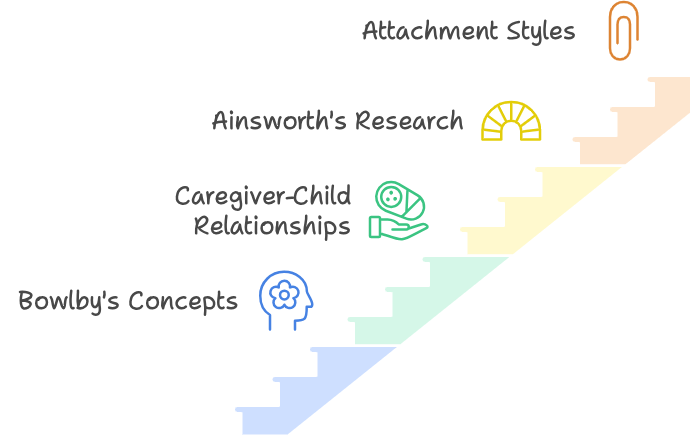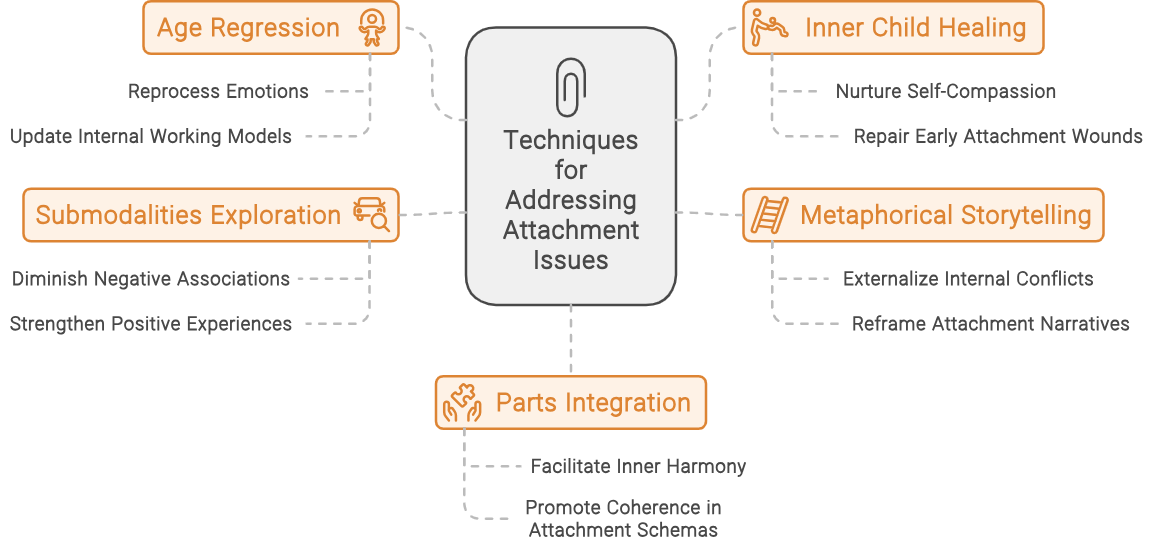Attachment theory has long served as a foundational framework in understanding how early relationships shape individuals’ emotional landscapes, influencing how they connect with others.
By combining attachment theory with Cognitive Hypnotic Psychotherapy (CHP), therapists gain powerful tools to promote deep healing, reframe maladaptive thought patterns, and guide clients toward improved relational and emotional resilience.
Origins and Development of Attachment Theory

This theory emerged from the pioneering work of John Bowlby and Mary Ainsworth in the mid-20th century.
Bowlby, drawing from Freudian concepts of unconscious dynamics and object relations, highlighted the significance of early caregiver-child relationships in shaping emotional bonds and interpersonal patterns throughout life.
Ainsworth’s research further classified attachment styles based on observed behaviours in the Strange Situation experiment, laying the foundation for understanding secure, anxious-preoccupied, dismissive-avoidant, and fearful-avoidant (disorganized) attachment patterns.
The Four Attachment Styles
Central to attachment theory are attachment styles—patterns of behaviour and emotional response observed in relationships. These styles develop based on early interactions with caregivers and shape individuals’ beliefs about themselves, others, and relationships throughout their lives.
They influence how individuals perceive and respond to emotional cues, conflict, and intimacy in their adult relationships.
- Secure Attachment:
- Description: Children with secure attachment feel confident that their caregivers will be available and responsive to their needs. They are comfortable exploring their environment and seek comfort from caregivers when distressed.
- Characteristics: As adults, securely attached individuals tend to have trusting, stable relationships. They are capable of intimacy, have good emotional regulation, and are responsive to their partners’ needs.
- Anxious-Preoccupied Attachment:
- Description: Children with anxious-preoccupied attachment may exhibit clingy behaviour and are hyperaware of their caregivers’ availability. They may be anxious even when their caregivers are present and easily distressed when separated.
- Characteristics: Adults with this attachment style often seek high levels of intimacy, approval, and responsiveness from partners. They may worry about their partner’s feelings for them and fear rejection or abandonment.
- Dismissive-Avoidant Attachment:
- Description: Children with dismissive-avoidant attachment may seem emotionally independent and may avoid or ignore their caregivers. They may not seek comfort or support from caregivers and may prefer to play alone.
- Characteristics: Adults with dismissive-avoidant attachment tend to avoid intimacy and closeness in relationships. They may value independence, prioritize self-reliance, and suppress their emotions, especially in stressful situations.
- Fearful-Avoidant (Disorganized) Attachment:
- Description: Children with fearful-avoidant attachment may exhibit a mix of avoidant and anxious behaviours. They may show fear or confusion in the presence of caregivers and may have unpredictable responses to attachment figures.
- Characteristics: Adults with fearful-avoidant attachment often struggle with trusting others and themselves. They may desire close relationships but fear emotional intimacy, leading to a cycle of pushing away and then seeking closeness.
Attachment Across the Lifespan

Attachment dynamics extend beyond infancy, influencing relationships and psychological functioning across the lifespan. Early attachment experiences shape individuals’ internal working models, impacting their ability to trust others, regulate emotions, and form intimate connections.
Understanding these lifelong implications helps psychologists identify underlying attachment patterns that contribute to clients’ current struggles and relational difficulties.
The Role of CHP in Addressing Attachment Issues
Cognitive Hypnotic Psychotherapy (CHP) integrates tools from cognitive-behavioural therapy (CBT), hypnosis, neurolinguistic programming (NLP), psychodynamic therapy, and humanistic techniques to help clients access and reframe deeply rooted attachment issues.
CHP provides a structured approach that engages clients on both conscious and subconscious levels, empowering them to break free from ingrained attachment patterns and form healthier relational models.
Techniques from CHP for Addressing Attachment Issues:

- Age Regression: Using hypnotic regression techniques, therapists guide clients to revisit early attachment experiences. This allows clients to reprocess unresolved emotions and update outdated internal working models, fostering healing and integration.
- Inner Child Healing: Through hypnotic techniques, therapists facilitate dialogue and healing between the adult self and the wounded inner child. This approach helps clients nurture and repair early attachment wounds, promoting self-compassion and emotional growth.
- Metaphorical Storytelling: Leveraging metaphors in CHP sessions, therapists create narratives that resonate with clients’ attachment experiences. This technique helps externalize internal conflicts, providing a safe space for exploration and reframing of attachment narratives.
- Submodalities Exploration: CHP employs techniques to explore sensory details (submodalities) associated with attachment representations. By adjusting these details under hypnosis, therapists help clients diminish negative emotional associations and strengthen positive attachment experiences.
- Parts Integration: In cases of internal conflict stemming from disorganized attachment, parts integration techniques help reconcile conflicting aspects of self. By facilitating inner harmony and alignment, therapists promote coherence in clients’ attachment schemas and overall psychological well-being.
Step-by-Step Integration of CHP Techniques to Address issues stemming from Attachment theory
Step 1: Identification of Attachment Style
- Begin with a thorough assessment using interviews and questionnaires to determine the client’s attachment style.
- Techniques: Utilize accessing cues and representational system analysis to understand how clients process information.
Step 2: Exploration of Early Attachment Experiences
- Use hypnosis to guide clients back to their childhood memories, exploring the origins of their attachment style.
- Techniques: Hypnotic regression therapy and inner child healing help uncover and address these early experiences.
Step 3: Addressing Maladaptive Thought Patterns
- Work on cognitive restructuring to change negative and unproductive thoughts.
- Techniques: Implement When-Then statements and belief change processes to develop healthier thought patterns.
Step 4: Emotional Healing and Regulation
- Employ techniques to release trapped emotions and build emotional resilience.
- Techniques: Emotional empowerment techniques and release metaphors facilitate emotional healing.
Step 5: Behavioural Interventions
- Focus on modifying problematic behaviours through reinforcement and habit change.
- Techniques: Use anchoring, the SWISH pattern, and NLP time travel to instill new, positive behaviours.
Step 6: Integrating New Insights and Behaviours
- Ensure changes are solidified through practice and reinforcement.
- Techniques: Parts integration and transformational metaphors help clients incorporate new insights and behaviours into their daily lives.
Step 7: Continuous Monitoring and Adjustment
- Continuously assess progress and adapt treatment plans as needed.
- Techniques: Employ meta model questioning and regular evaluation to ensure ongoing improvement.
Case Studies: Real-Life Applications of Attachment Theory and CHP
- Anxious Attachment and Relationship Anxiety: A client with anxious-preoccupied attachment might exhibit clinginess and fear of rejection in relationships. By applying CHP’s step-by-step process, the client can develop greater emotional independence, leading to improved relationship stability and reduced anxiety.
- Avoidant Attachment and Intimacy Issues: For clients with dismissive-avoidant attachment, intimacy can feel threatening. Through techniques like inner child healing and submodalities exploration, clients learn to foster closeness without compromising their sense of self.
- Disorganized Attachment and Emotional Regulation Problems: Disorganized attachment often results in difficulty with emotional regulation. By addressing unresolved traumas and integrating parts of self through CHP, clients can achieve greater emotional balance and resilience.
Practical Considerations for Therapists
Using attachment theory and CHP in clinical settings requires a sensitive, individualized approach. Psychologists should build trust with clients, respecting each person’s unique relational history. Additionally, being mindful of cultural differences and potential client resistance to hypnosis or introspective exercises is crucial for fostering effective therapeutic alliances and outcomes.
Enhancing Clinical Practice through CHP Training
For practicing psychologists, gaining expertise in CHP offers:
- Expanded Therapeutic Techniques: CHP combines hypnosis with CBT, NLP, and psychodynamic methods, enriching the therapist’s toolkit.
- Improved Client Outcomes: Personalized treatment plans that address subconscious blocks and attachment-based issues lead to better results and satisfaction.
- Professional Growth: CHP training enhances therapists’ skills and differentiation, positioning them as experts in a highly specialized therapeutic approach.
Conclusion
Attachment theory remains a cornerstone of contemporary psychotherapy, offering psychologists a comprehensive framework to understand and transform clients’ relational dynamics and emotional well-being.

By integrating this theory with Cognitive Hypnotic Psychotherapy, practitioners unlock powerful tools to address attachment-related issues effectively, fostering deep emotional healing and resilience in their clients’ lives. Embrace the transformative potential of attachment theory in your practice to enrich therapeutic outcomes and cultivate meaningful client connections.

